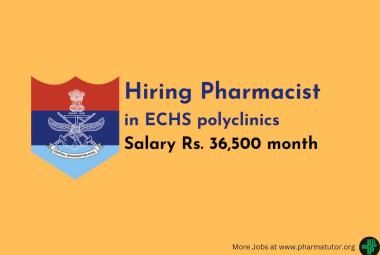About Author:
Mahendra N. Suthar
M.S. (pharm.) Biotechnology
National institute of pharmaceutical education and research,
Mohali, Punjab-160062.
mahendramevada8@gmail.com
Abstract:
Pharmaceutical industry is a most diverse, R&D oriented, hypercompetitive and knowledge sensitive industry. Competitive intelligence (CI) is a process of ethically and systemic data gathering from operating system to draw important business conclusions. Use of CI for drawing important conclusions regarding present scenario and future forecasting is very important and growth determining practice of pharmaceutical industries. Intellectual property rights (IPR) is an integral part of the industry and IPR related information is freely available in public patent databases. By analyzing patents company can derive important conclusion regarding competitor’s R&D activities, quality of research, collaboration and alliance and can convert this information to knowledge which can play important role in taking future decisions. Present review is fully focused on advent of IPR in getting very good information regarding competitor’s strategies and tactics.
REFERENCE ID: PHARMATUTOR-ART-1840
1. Introduction
Pharmaceutical industry in one of the prominent industry though out the globe and further it is in growing phase1, 2, so innovative activities and strategies play important role in the growth of industry2, 3. However the flip side is that, there is stiff competition between companies for same drug molecule, same disease area or for the same treatment3, 4, 5. Ethically looking over strategies and tactics of Competitors, company can drive important conclusions regarding present scenario and can also forecast about future5, 6.
Intellectual property rights (IPR) is an integral part of the pharmaceutical industry7, 8. Information of patents is freely available in various patent databases. By analyzing intellectual property (IP) information important conclusion regarding rivalry activities can be drawn out7, 8, so pharmaceutical industry uses IP as a tool for competitive intelligence (CI) 8, 9. Further advents of IP in CI are elaborated in coming section.
2. Pharmaceutical industry at a glance
Pharmaceutical industry is a one of emerging and prominent industry of the globe1, 2, 3, it is aptly described as a key asset to scientific and medical progress2, 3. In 2012, total revenue of pharmaceutical industry was more than USD 1 trillion2, 3and it is forecasted USD 1.5 till 20154. In present scenario U.S.A and Europe are contributing about 41.8% and 26.8% share of market of the market respectively1, 2, 3. Higher growth rate and emerging market including China, India, Brazil Russia and Mexico etc. (known as pharmerging), contribute around 15% of market share1, 3. IMS forecast that pharmerging will meet 28% market by the end of 20151.
Indian pharmaceutical industry is also emerged as one of the leading industry, with market revenue sowing unprecedented growth from USD 0.3 billion in 198010to about USD 25 billion by 201211, 12. India ranks 3rd in term of volume and 13th in term of total revenue10, 11, 12. Indian pharmaceutical industry has come a long way, being almost non-existence before independence to become prominent provider of healthcare products10. By meeting almost 95 percent of country’s pharmaceutical and healthcare needs and earning about USD 5000 millions foreign exchange12, Indian pharmaceutical industry became one of the most significant industries of the country10, 11, 12.
3. Intellectual property in Pharmaceutical industry
Intellectual property rights (IPR) are given to individuals or group of people for their creativity of mind, it can be defined as “Ideas, inventions, and creative expressions derived from intellects of individual or group of people which have commercial value”7, 8
IPR provide certain exclusive right to inventors in order to give them reward for their efforts and further to propel innovation7, 8. Patents, Copy rights, trademarks, plant breeder’s rights, industrial design etc. are major right given to intellectual of individual or group of people7, 8. IPR are only legal was to convert intellectuals to money making assets13. Each country has their own standards and regulation of patents, so filling patent in individual country is required 14. With the patent cooperation treaty (PTC) one can file global patents, but it requires further examination of individual country14, 15.
Pharmaceutical industry is one of the most diverse, knowledge driven and technology intensive industry where innovative advancement can really generates resources14. Each medicine is result of long and costly research and development process;16, 17developing and bringing product to market is very complex process, but very easy to imitate14, 15. So that process and product must have IP protection14, 15. In pharmaceutical field generally patents are granted to new chemical entity (NCE), generic classis of compounds, novel metabolic, bio-processors, formulation, screening methods etc.14, 15. But only condition is that it should be genuine invention and should have industrial application15.
4. Competitive intelligence and Intellectual property
Competitive intelligence (CI) has a role in every pharmaceutical company6. Identifying knowledge assets within an organization can lead to new revenue sources6. Patents, trade mark and other IPR related data provide good indication and information of competitive companies or brands6. In this review few of many approaches related to IP and CI are elaborated.
4.1 Introduction of competitive intelligence
Systematic data gathering and analysis of the operating environment of the companies is known as competitive intelligence (CI)18. Precisely it is defined as, “Process of ethically collecting, analyzing and disseminating related, specific, timely, accurate foresighted and actionable intelligence regarding business environment competitor itself 19”
In sort the practice of CI involve systemic process of transform information in to knowledge of effective corporate decision18, 20. CI could helpful for finding new business opportunity, to avert disaster, finding new customers, retaining all ready existing customers, to look strategy of competitors and also empower the firm to monitoring its own development21. CI is also one of effective tools for marketing research; in development of new scenario, scanning present day data and forecasting future trends20.
Basic process of CI often known as intelligence cycle; process by with raw information is converted in to useful knowledge. It is cyclic process contains mainly following steps21,
Certain societies also guide and promote use of CI in industry strategic and competitive intelligence professionals (SCIP)19and Research and analytical wing (RAW, India) are well known society for CI20, 21.
4.2 Role of competitive intelligence in pharmaceutical industry
Pharmaceutical industry is hypercompetitive and highly knowledge sensitive22so, CI is playing important role in growth of the industry23. CI can be used in to whole life cycle of the drugs, including clinical trials, Regulatory and commercializing23. Further used in marketing analysis and for finding new business opportunities. Company can look strategy and tactics of competitors and monitor its own growth23.
Big pharmaceutical companies have their own CI cells. CI cells of Novartis and Procter and Gamble are well known in pharmaceutical industry24. Most of pharmaceutical industries higher knowledge process out sourcing (KPO) firms for CI24. IMS, Global data, Evalueserve, Thomson Reutter, Frost and Sullivan, TNS etc. are international KPOs cater in the field of CI and marketing research25.
4.4 Information can be extracted from patents
IP can be used as CI’s tools to gain inside the industry and it is significant indicator in what competitors are involved in24, 25. It helps in finding competitors research and developments activity, collaboration and alliance and also available recourses25. IP data bases like uspto.gov, espacenet.com, pfc.in, PATSCAN etc. are freely available14, 15. Using that one can search, collect and analyze IP related information14, 15.
Contains of the patents is a good source of knowledge24, 25. Following importance information can be derived by patent analysis;
1. A glance at front pages of patent indicates quality of document and research. If patent holder is individual than it indicate poor resources of invention25, 26.
2. Patents on name of firm or on the name of group of inventor than it indicate that strong resources and higher R&D quality could be involved in research25.
3. If patent is filled in PTC than it indicate confidence in research25, 27.
4. Continuous part of patent indicates that research is very serious and could have higher rewards25.
5. By reviewing legal history of infringement, opposition and re- examination indicates degree of enforcements25, 26.
6. Strong citation indicates quality of research25, 26.
7. If patent is filled by reputable institute or reputable company than it indicates quality of research25.
NOW YOU CAN ALSO PUBLISH YOUR ARTICLE ONLINE.
SUBMIT YOUR ARTICLE/PROJECT AT articles@pharmatutor.org
Subscribe to Pharmatutor Alerts by Email
FIND OUT MORE ARTICLES AT OUR DATABASE
5. Conclusion and Future prospects
CI can play important role in hypercompetitive, highly R&D oriented and knowledge sensitive pharmaceutical industry. By analyzing IP back ground important conclusion regarding R&D activity, research collaboration and financial resources of competitors can be drawn out. Sometimes certain companies do unethical practice and enter at back door of competitor’s premises to unveil confidential information, this is very serious concern but most of companies do not pursue that practice. Conclusively, using IP ethically as a tool of CI, pharmaceutical company can look global scenario of pharmaceutical word and can attend higher growth.
Information and technology oriented word could develop higher technology for searching, collecting and analysis of patent databases and IP knowledge. Development of super computers which automatically search and analyze information is highly awaited and could make whole process easy and more accurate. While pharmerging like India and China could empower their available human resources in CI and could deliver quality of resources.
Acknowledgements:
This article is dedicated to my beloved family and beauty of the life. I want to acknowledge my institute NIPER, Mohali for providing me platform for my academic success by delivering quality of education and providing me very good resources. I acknowledge my friends Divyesh, Avathesh, Moulik, Tejas and to all NIPERITES for supporting and appreciating me for this work. Last but not the least I thank Almighty, for all his blessings he bestowed upon me.
References:
1. Global pharma outlooks-2015, Express pharma-2011. expresspharmaonline.com
2. Global pharma and Biotech M&A report-2012, An IMAP industry reports-2012. imap.com.
3. 2012 profile: Pharmaceutical industry. PhRMA report-2012. phrma.com.
4. Andrew M. Lacy. Analyzing competition in pharmaceutical industry. Economic committee newsletters, 10 (1), 2008.
5. Competition and regulation issues in pharmaceutical industry. OECD-2000, oesd.org
6. Pharmaceutical competitive intelligence for the regulatory affairs professional. Terkko Navigator-2012. terkko.helsinki.fi.
7. Pallavi Mahajan. Advent of intellectual property rights in the pharmaceutical industry. Social science research network, 1820627, 2011.
8. Intellectual property rights in the pharmaceutical industry. Social science research network, 1820627, 2011.
9. Rom Simmer. Using intellectual property rights data for competitive intelligence. Licensing executive society USA&CANADA, 2011.
10. A brief report on pharmaceutical industry in India. Corporate catalyst of india-2012, cci.in
11. Indian pharmaceutical industry-growth story to continue. Expresspharma-2012, expresspharmaonline.com.
12. Healthcare in India: Emerging market report. Powerwaterhousecooper-2012, pwc.com.
13. Chandra Nath Saha and Sanjib Bhattacharya. Intellectual property rights: An overview and implication in pharmaceutical industry. Journal of advanced pharmaceutical technology and research, 2 (2) 2011.
14. Intellectual property and pharmaceuticals. The European federation of pharmaceutical industry and associations-2008. efpia.eu.
15. Nevin M. Gewertz and Rivka Amado. Intellectual property and pharmaceutical industry: A moral crossroads between health and property. Journal of business ethics, 55 (3) 2004.
16. New drug development and review process. Center for drug evaluation and research (CDER) handbook-1998. fda.gov.
17. Surabhi Sharma. Introduction to drug development and FDA approval process. Journal of clinical research best development practices, 7 (9) 2011.
18. Daniel Rouach. Competitive intelligence adds value: Five intelligence attitudes. European management journal, 19 (5) 2001.
19. Strategic competitive intelligence professionals (SCIP) 2013. scip.org.
20. Timothy Powel. Enhancing sales and marketing effectiveness through competitive intelligence. Competitive intelligence review, 9 (4) 1998.
21. Tsokanas Nikolaos and Fragouli Evangelia. Competitive intelligence: concepts, context and case of its implication. Science journal of business management, 2012 (2) 2012.
22. Maria-Angeles de Frutosa and Carmine Ornaghib. Competition in the pharmaceutical industry: How do quality differences shape advertising strategies? Journal of health economics, 2013 (32) 2012.
23. Tsokanas Nikolaos, Fragouli Evangelia. Competitive intelligence for pharmaceutical science: The case of Greece. Science journal of business managements, 2012 (2) 2012.
24. Meng-Jung Shih and Duen-Ren Liu. Discovering competitive intelligence by change in patent trends. Expert system with application, 37 (2) 2010.
25. Role of IP in competitive intelligence gathering and analysis. Word intellectual property organization (WIPO), 2013. wipo.int.
26. Competitive intelligence for intellectual property is fine, but use it wisely. Think IP strategy, 2013. thinkipstrategy.com.
27. Patent cooperation treaty. Patent lance-2013. patentlence.com
NOW YOU CAN ALSO PUBLISH YOUR ARTICLE ONLINE.
SUBMIT YOUR ARTICLE/PROJECT AT articles@pharmatutor.org
Subscribe to Pharmatutor Alerts by Email
FIND OUT MORE ARTICLES AT OUR DATABASE









